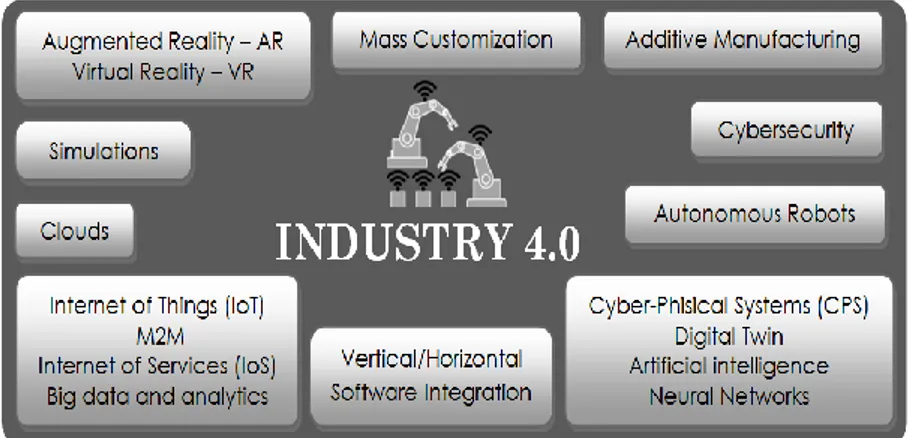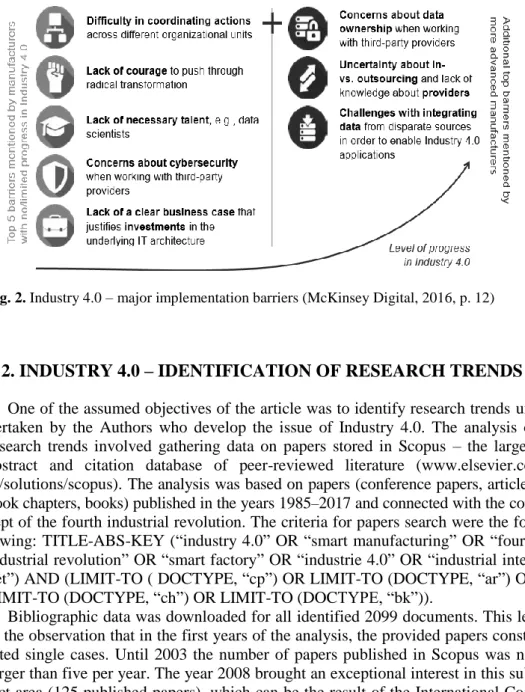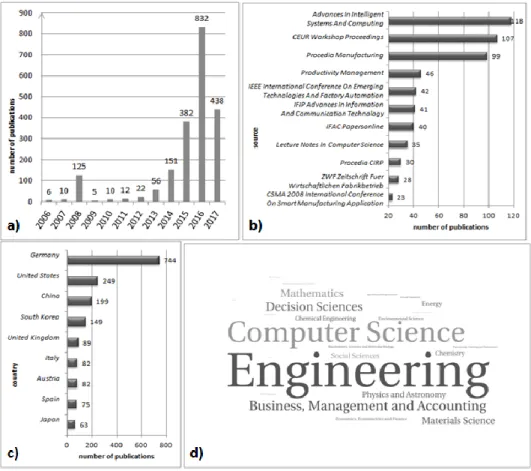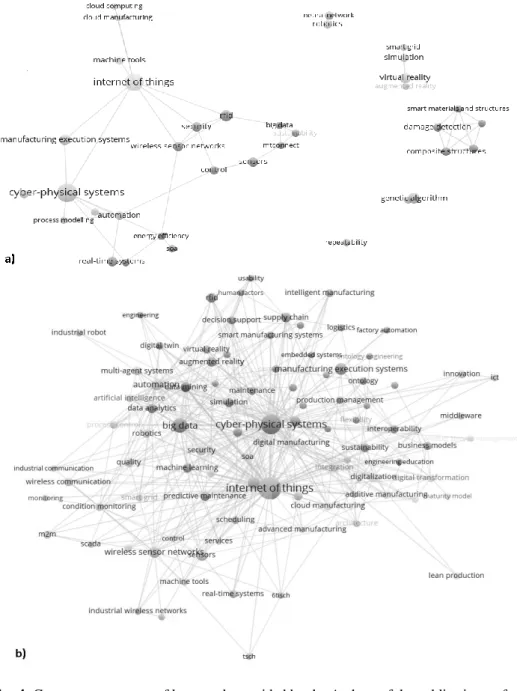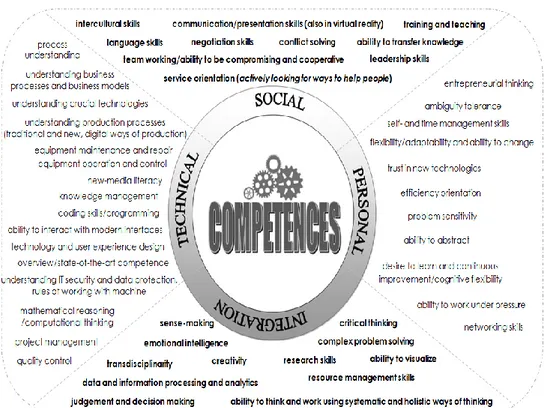TRANSFORMATION TOWARDS INDUSTRY 4.0 –
IDENTIFICATION OF RESEARCH TRENDS AND
ASPECT OF NECESSARY COMPETENCES
IN THE LIGHT OF SELECTED PUBLICATIONS
Alicja E. Gudanowska
Faculty of Management, Bialystok University of Technology, O. Tarasiuka 2, 16-001 Kleosin, Bialystok, Poland, Email: a.gudanowska@pb.edu.pl
Abstract. The concept of Industry 4.0 associated with the increasing digitization of the entire
production system is often described as the fourth industrial revolution. The fourth wave assumes a progressive digitization of the value chain in the industry and the development of the networks of contractors, machines, objects, processes and systems that exchange information immediately. These new realities, determine the need to adapt and enhance the qualifications of workers in industrial enterprises. It is natural to ask about the set of competences that will be significant from the perspective of the transition towards Industry 4.0. General purpose of this article is to try to answer this question. In the first part of the article the concept of Industry 4.0 is briefly described. Special attention was paid to the analysis of the network of thematic areas, in which the publications related to this topic are presented. The final part of the article deals with an analysis of the set of competences that will be needed while working in the realities of the fourth industrial revolution.
Paper type: Literature review Published online: 19 October 2017 Vol. 7, No. 5, pp. 431–441
DOI: 10.21008/j.2083-4950.2017.7.5.4 ISSN 2083-4942 (Print)
ISSN 2083-4950 (Online)
© 2017 Poznan University of Technology. All rights reserved. Keywords: Industry 4.0, research trends, competence
1. INTRODUCTION
Industry 4.0 is a concept identified with the fourth industrial revolution. The first revolution started at the end of the 18th century in Great Britain. It was con-nected with the use of water energy and the invention of the steam engine that changed the image of textile industry as well as led to work mechanisation. The start of mass production of inexpensive products for consumers, the use of electric power, the production of steel products and the appearance of telegraphic and rail-way systems at the turn of the 19th and 20th centuries make the highlights of the second industrial revolution. The third revolution was brought by the use of com-puter technologies in the 70s of the 20th century. Their application allowed for continuous automation of manufacturing processes, at the same time contributing to the global economic growth. The digital era is a time when intelligent electronics unceasingly pushes us into the direction of a higher level of communications and mobility. Today we face the fourth, most complicated industrial revolution. Its final result is intended to be an intelligent factory where intelligent networks join ma-chines, processes, systems, customers and suppliers. We observe constant automa-tion, optimisation of products and processes, where vast databases are processed in real time. This revolution is characterised among other things by the application of cyber-physical systems (CPS), cloud technologies, Internet of Things (IoT) and Internet of Services (IoS), their integration and interaction with people in the manufacturing environment. It should be noted that this revolution brings changes in the entire society, including technology and production, but also consumption and other spheres of life. The direct engine of the transformation is not industry but the development of such issues as network analysis or intelligent appliances (Hwang, 2017, pp.10–11; Stadnicka, Zielecki & Sęp, 2017, p. 473; Li Guoping, Hou Yun & Wu Aizhi, 2017, pp. 626–627; Magruk, 2016, pp. 275–276).
Despite worldwide, large interest in the concept, not a single commonly ac-cepted definition of Industry 4.0 has been developed yet (Mrugalska & Wyrwicka, 2017, p. 469). This term can be understood as a form of organising a value network, encompassing digitalisation of material production that constitutes an element of an intelligent network. CPS monitor physical processes, create a virtual copy of the physical world and undertake autonomous and decentralised decisions, communi-cating with one another and people in real time thanks to IoT. Digital communica-tions allows for automatic and self-optimising production of goods and thanks to IoS both internal and cross-organisational services are used by all participants of the value chain (Hermann, Pentek & Otto, 2015, p. 11; Hofman & Rüsch, 2017, p. 25; Magruk, 2016, p. 277). Industry 4.0 is a manner of advancing the manufac-turing process so as to satisfy individual requirements and short-term requests of customers, and make the time for launching a product as short as possible (Basl, 2017, p. 4). This concept can also be described from the perspective of the Smart Product (the work piece is changing from a passive to an active part of the
produc-tion system), the Smart Machine (a tradiproduc-tional producproduc-tion hierarchy is replaced by a decentralized self-organization) and the Augmented Operator (connected with the automation of knowledge which makes it the most flexible and adaptive part in the production system) (Mrugalska & Wyrwicka, 2017, pp. 469–470). The compi-lation of technological solutions that allow for concept implementation is presented in Figure 1.
Fig. 1. Technological solutions that enable the implementation of the concept of Industry 4.0 (visualization based on Stadnicka, Zielecki & Sęp, 2017, p. 474; Hwang, 2017, p. 10)
Germany is considered the most advanced country in implementing Indus-try 4.0, where this concept was introduced for the first time. Measures connected with its implementation are supported by the German government (which is proven by e.g. launching a strategic development programme “Industrie 4.0”). Also other countries such as the USA, China and Singapore prioritise the issues connected with the fourth industrial revolution (Gontarz, 2016). However, implementing this concept is not easy and the producers that face this task can encounter a range of significant barriers at various stages of implementation. Figure 2 shows the most important ones.
The Polish economy, being one of European economies that employ the largest number of people in industry, may undergo significant changes under the influence of implementing Industry 4.0 (Stadnicka, Zielecki & Sęp, 2017, p. 473). Still – as shows the diagnosis for preparing the Polish industry for implementation – at pre-sent only 15% of the Polish factories are fully automated and 76% seem to be partly automated. Moreover, only a small share of factories use IT systems for operational management and production steering (Manufacturing Execution Sys-tems – MES). Poland still lacks strong infrastructure allowing for automation and computerisation of production. A shift to level 4.0 also requires large investments in educating fairly competent managers and engineers in order to implement and maintain the latest technologies (Iwański & Gracel, 2016, pp. 12–15).
Fig. 2. Industry 4.0 – major implementation barriers (McKinsey Digital, 2016, p. 12)
2. INDUSTRY 4.0 – IDENTIFICATION OF RESEARCH TRENDS
One of the assumed objectives of the article was to identify research trends un-dertaken by the Authors who develop the issue of Industry 4.0. The analysis of research trends involved gathering data on papers stored in Scopus – the largest abstract and citation database of peer-reviewed literature (www.elsevier.co-m/solutions/scopus). The analysis was based on papers (conference papers, articles, book chapters, books) published in the years 1985–2017 and connected with the con-cept of the fourth industrial revolution. The criteria for papers search were the fol-lowing: TITLE-ABS-KEY (“industry 4.0” OR “smart manufacturing” OR “fourth industrial revolution” OR “smart factory” OR “industrie 4.0” OR “industrial inter-net”) AND (LIMIT-TO ( DOCTYPE, “cp”) OR LIMIT-TO (DOCTYPE, “ar”) OR LIMIT-TO (DOCTYPE, “ch”) OR LIMIT-TO (DOCTYPE, “bk”)).Bibliographic data was downloaded for all identified 2099 documents. This led to the observation that in the first years of the analysis, the provided papers consti-tuted single cases. Until 2003 the number of papers published in Scopus was not larger than five per year. The year 2008 brought an exceptional interest in this sub-ject area (125 published papers), which can be the result of the International Con-ference On Smart Manufacturing Application that was held at that time (118 among all papers published in 2008). In the following years, despite initial decrease, the interest in this subject was growing, which is confirmed by the grow-ing number of related publications indexed in Scopus. A special interest has been observed within the last three years, where the number of papers exceeded 350 per
year (Fig. 3a). The analysed papers were of different origins and presented research or views of authors coming from various countries (most represented – Fig. 3b and Fig. 3c). The majority of papers were ranked in Scopus areas: Engineering and Computer Science. In smaller numbers they were also classified in the following areas: Business, Management and Accounting; Decision Sciences; Mathematics; Materials Science; Physics and Astronomy (Fig. 3d).
Fig. 3. Data on the analysis of research trends related to Industry 4.0 context, indexed in Scopus database: a) number of publications in 2006–2017; b) most popular sources of pub-lication; c) most popular countries/territory; d) cloud of subject areas
The generated bibliographic databases were analysed with the use of VOSvie-wer software, which is particularly useful while working with large volumes of data. The software allows for emphasising the aspect of the frequency of given elements in the network and at the same time the frequency of their coexistence. The gathered data constitutes a basis for preparing maps of the co-existence of key words entered by the authors of publications. The analysis was focused on distinguishing
the last three years (2015–2017, Fig. 4b) and an earlier period (1985–2014, Fig. 4a). In order to ensure the map’s clarity, the Author accounted for key words that appear at least 3 times (Fig. 4a) or 5 times (Fig. 4b) in the analysed set.
Fig. 4. Co-occurrence maps of key words provided by the Authors of the publications referring to the context of Industry 4.0, indexed in Scopus in years: a) 1985–2014 and b) 2015–2017
The analysis involved key words provided by the Authors of the publications and the aspect of their co-existence. A special focus was devoted to original key words as those elements of the publications best characterise the issues developed in papers. The Author made connections between identical terms in terms of their meaning and at the same time disregarded filter words that constitute selection criteria for publications. The most common key words were located in the central part of the publication. Also the size of the nodes representing each of the appear-ing terms as well as the font size that was used while savappear-ing the name of a given node indicate the frequency of a given term. One of the functionalities of VOSvie-wer is combining the analysed set of data in clusters denoting the most common co-existence of given terms. With regard to editor’s requirements, the paper disre-gards the colouring of clusters on the presented map. The analysis of Figure 4 indi-cates that the network of the most common key words underwent modifications. A growing interest in this issue is visible in the number of publications, proven by the density of the network. The issues that were most dynamically developed in the first analysed period (1985–2014) constituted the pillars of Industry 4.0, namely IoT or CPS, as well as MES, wireless sensor networks in connection with security and RFID. The element of the same cluster were the issues of cloud computing and cloud manufacturing as well as a part connected with big data and communica-tions. Separate clusters constituted the aspects of: damage detection in connection with composite structures; virtual reality and simulations, robotics and neural net-works. However, in the last three years (2015–2017) there has been observed a consistently large interest in base technologies connected with Industry 4.0: IoT and CPS. However, the concept of big data has also advanced to this rank. Other popular areas are: automation, machine learning, digitalization and constantly de-veloped wireless sensor networks, MES and the security context. Also there has been a growth in popularity with regard to the contexts that did not appear in the previous years, such as artificial intelligence, lean production, quality, predictive maintenance, business models, human factors and decision support.
3. INDUSTRY 4.0 – ASPECT OF NECESSARY COMPETENCES
Taking into account the observation resulting from literature review in terms of requiring investments in the education of managers and engineers, as well as one of the visible research trends reflecting the interest in the issues of human factors and decision support, the second objective of the paper was searching for a set of competences that will be significant from the perspective of transformations into the direction of Industry 4.0. The essence of competences is also highlighted by the observation of the barriers to implementation, as indicated in the article’s introduc-tion. One of the most significant ones was the barrier of lack of necessary talent, emphasised by the producers at the first stages of implementation. The basiccon-cern that appears in the context of Industry 4.0 development is the assumption that the implementation of the concept will be associated with increased unemploy-ment.
Fig. 5. Necessary competences in the context of Industry 4.0 (based on: Kinkel, Schem-mann & Lichtner, 2017, pp. 325–327; Davies, Fidler & Gorbis, 2011, pp. 8–12; Gehrke et al., 2015, p. 13; Simonsa, Abéa & Neserb, 2017, p. 83; Global Challenge Insight Report, 2016, pp. 52–53; Erol et al., 2016, p. 14–15; Hecklau et al., 2016, p. 4)
Although the development of automation and robotics poses a threat to people performing simple and repetitive operations in the manufacturing process, the ap-pearance of machines will lead to the creation of workplaces, and some production areas may not be automated at all for economic reasons (Iwański & Gracel, 2016, p. 28; Becker & Stern, 2016, p. 407). From that perspective any operations aimed at searching for competences that in the future will be indispensable attributes of production employees in order to react faster and earlier to the upcoming changes, seem justified. As Kinkel et al. reports, there are many ways of understanding competences, which makes it difficult to make a distinction between competences, knowledge and skills. Competence can be meant as “the individual dispositional ability and readiness to act successfully and self-organized when facing novel,
unstructured or complex situations or tasks and the ability to develop solutions for future situations” (Kinkel, Schemmann & Lichtner, 2017, p. 324). Competences are based on activating, combining and applying personal resources, such as knowledge, networks, cognitive and practical skills, including social, personal and methodological ones in work or study situations and in professional and per-sonal development (Kinkel, Schemmann & Lichtner, 2017, p. 324; Recommenda-tion…, p. 2). Figure 5 presents the result of the conducted literature analysis within the necessary competences in the context of Industry 4.0.
Despite a visible quantitative prevalence of technical competences (Fig. 5), it should be observed, that strong and dominant technical background of today’s en-gineers are merely one group of attributes that characterise the enen-gineers of the future. At the time of transformations, as a result of enormous change dynamics, the essence of many innovative technologies and their applications affects the manner of executing projects and problem solving, and in effect it also brings the necessity to develop skills so far perceived as soft – non-engineering – ones (Iwań-ski & Gracel, 2016).
4. CONCLUSION
The fourth industrial revolution entails making an impact on satisfying new re-quirements of customers and the application of modern technologies. This, in turn, requires qualified human resources today and in the future (Li Guoping, Hou Yun & Wu Aizhi, 2017, p. 630). The modification will involve not only work condi-tions, but requirement profiles as well. Machines will increasingly contribute to the execution of standard and repetitive tasks, and the need for the personnel that will be able to configure and operate them will grow as well (Schulz, 2015, p. 4). The results of the analysis conducted in this area provided by various Authors indicate that the advancing automation not necessarily has to generate unemployment; on the contrary, it can positively affect the society’s development and the perception of an industrial enterprise on the domestic or global market. Individuals in charge of contemporary industrial undertakings have to appreciate and develop employ-ees’ competences that will enable them to overcome future difficulties. Employee training and development seem indispensable, but it is the entire educational sys-tem that should react to the changing requirements (Janssen et al., 2016, p. 20; Gehrke et al., 2015, p. 14).
The analysis of literature concerning the issue of the fourth industrial revolution as well as the analysis of numerous publications in this subject area point to a great interest in this subject. Moreover, research trends in this area also bring awareness of the pace of modifications that take place in this scope. The perception of an en-gineer in the light of industry transformation also changes. A greater importance is attached to competences other than those previously considered as the most
signifi-cant ones. A strong, until lately dominating technical basis is complemented by increasingly significant, soft competences that become indispensable for the engi-neers of the future. A further, interesting stage of the analyses described in the arti-cle could be the determination of the desired level of indicated competences in an enterprise that successfully functions in the reality of Industry 4.0. Also searching for ways of measuring the current level of competences and indicating a compe-tence gap between the existing and the desired states seem to be an interesting re-search area.
ACKNOWLEDGEMENTS
The research were conducted within S/WZ/1/2014 project and were financed from Ministry of Science and Higher Education funds.
REFERENCES
Basl J. (2017), Pilot study of readiness of Czech companies to implement the principles of Industry 4.0, Management and Production Engineering Review, Vol. 8, No. 2, pp. 3–8. Becker T. & Stern H. (2016), Future trends in human work area design for cyber-physical
production systems, Procedia CIRP, Vol. 57, pp. 404–409.
Davies A., Fidler D. & Gorbis M. (2011), Future Work Skills 2020, Institute for the Future for the University of Phoenix Research Institute, <www.iftf.org/uploa-ds/media/SR-1382A_UPRI_future_work_skills_sm.pdf> [accessed: 15.07.2017].
Erol S., Jäger A., Hold P., Ott K. & Sihna W. (2016), Tangible Industry 4.0: a scenario-based approach to learning for the future of production, Procedia CIRP, Vol. 54, pp. 13–18. Gehrke L., Kühn A.T., Rule D., Moore P., Bellmann Ch., Siemes S., Dawood D., Singh L.,
Kulik J. & Standley M. (2015), Industry 4.0, A Discussion of Qualifications and Skills in the Factory of the Future: A German and American Perspective, <www.researchg ate.net/publication/279201790_A_Discussion_of_Qualifications_and_Skills_in_the_Fac tory_of_the_Future_A_German_and_American_Perspective> [accessed: 15.07.2017]. Global Challenge Insight Report (2016), The Future of Jobs Employment, Skills and
Work-force Strategy for the Fourth Industrial Revolution, World Economic Forum, <www.weforum.org/docs/WEF_Future_of_Jobs.pdf > [accessed: 15.07.2017].
Gontarz A. (2016), Trudna droga do Przemysłu 4.0, ComputerWorld, 21.12.2016, <www. computerworld.pl/news/Trudna-droga-do-Przemyslu-4-0,406943.html> [accessed: 15.07.2017].
Hecklau F., Galeitzke M., Flachs S. & Kohl H. (2016), Holistic approach for human resource management in Industry 4.0, Procedia CIRP, Vol. 54, pp. 1–6.
Hermann M., Pentek T. & Otto B. (2015), Design Principles for Industrie 4.0 Scenarios: A Literature Review, Working Paper, No. 01, Technische Universität Dortmund Fakultät Maschinenbau & Audi Stiftungslehrstuhl Supply Net Order Management, pp. 1–15. Hofman E. & Rüsch M. (2017), Industry 4.0 and the current status as well as future prospects on
logistics, Computers in Industry, Vol. 89, pp. 23–34.
Hwang S.J. (2016), The Fourth Industrial Revolution (Industry 4.0): Intelligent Manufacturing, SMT Magazine, July 2016, pp. 10–15.
Iwański T. & Gracel J. (2016), Przemysl 4.0 Rewolucja już tu jest. Co o niej wiesz?, ASTOR WHITEPAPER, <www.astor.com.pl/images/Industry_4-0_Przemysl_40/ASTOR_ptrze- mysl4_whitepaper.pdf> [accessed: 15.07.2017].
Janssen D., Tummel Ch., Richert A. & Isenhardt I. (2016), Virtual Environments in Higher Education – Immersion as a Key Construct for Learning 4.0, International Journal of Advanced Corporate Learning, Vol. 9, No. 2, pp. 20–26.
Kinkel S., Schemmann B. & Lichtner R. (2017), Critical Competencies for the Innova-tiveness of Value Creation Champions: Identifying Challenges and Work-integrated Solutions, Procedia Manufacturing, Vol. 9, pp. 323–330.
Li Guoping, Hou Yun & Wu Aizhi (2017), Fourth Industrial Revolution: technological drivers, impacts and coping methods, Chinese Geographical Science, Vol. 27, No. 4, pp. 626– 637.
Magruk A. (2016), Uncertainty in the sphere of the industry 4.0 – potential areas to research, Business, Management and Education, Vol. 14, No. 2, pp. 275–291.
McKinsey Digital (2016), Industry 4.0 after the initial hype. Where manufacturers are finding value and how they can best capture it, McKinsey & Company.
Mrugalska B. & Wyrwicka M.K. (2017), Towards Lean Production in Industry 4.0, Procedia Engineering, Vol. 182, pp. 466–473.
RECOMMENDATION OF THE EUROPEAN PARLIAMENT AND OF THE COUNCIL of 23 April 2008 on the establishment of the European Qualifications Framework for lifelong learning (2008/c111/01/EC), <www.eucen.eu/EQFpro/GeneralDocs/FilesFeb- 09/GLOSSARY.pdf> [accessed: 15.07.2017].
Schulz T. (2015), Industry 4.0 Koncepcja cyfrowej transformacji, GE Intelligent Platforms oraz VIX Automation, <automatykab2b.pl/technika/8876-industry-40-koncepcja-cyfrowej-transformacji#.WYGzyoVOLIU> [accessed: 15.07.2017].
Simonsa S., Abéa P. & Neserb S. (2017), Learning in the AutFab – the fully automated Industrie 4.0 learning factory of the University of Applied Sciences Darmstadt, Procedia Manufacturing, Vol. 9, pp. 81–88.
Stadnicka D., Zielecki W. & Sęp J. (2017), Koncepcja Przemysł 4.0 – ocena możliwości wdrożenia na przykładzie wybranego przedsiębiorstwa, [in:] R. Knosala (ed.), Innowacje w zarządzaniu i inżynierii produkcji, t. 1, Oficyna Wydawnicza Polskiego Towarzystwa Zarządzania Produkcją, Opole, pp. 472–483.
BIOGRAPHICAL NOTES
Alicja E. Gudanowska, PhD is an employee at the Bialystok University of Technology in Poland. Her scientific interests concentrate on future studies, technology management and visualization of knowledge with the special emphasis on the methodological issues and tools applied within it. She is an author or a co-author of over thirty publications – both in Polish and English – which touch upon the problems of technology management, technology mapping, knowledge mapping, technology roadmapping and the general methodology of future studies.
442 Alicja E. Gudanowska
-author of over thirty publications – both in Polish and English – which touch upon the problems of technology management, technology mapping, knowledge mapping, technology roadmapping and the general methodology of future studies.
